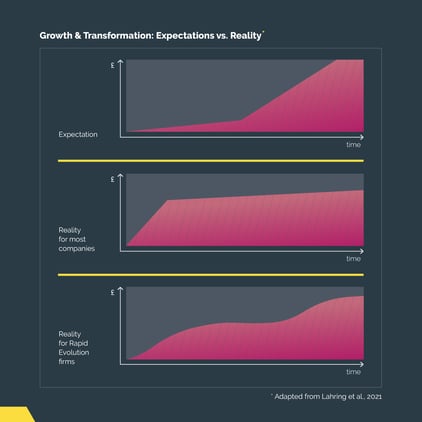Through our research process looking at rapid evolution, it soon became apparent that to succeed in a complex, ambiguous and rapidly changing operating environment, leaders need to balance the inevitable tensions created by fluctuating, and often competing, internal and external demands. Too little tension and we linger too long in our comfort zone, while the world (and our customers, clients or service users) move on around us. Too much tension and we risk burnout or disengagement. But without a degree of tension, there is no change, no forward movement.
When analysing the organisational characteristics that differentiate between organisations that are able to achieve rapid evolution and sustain this over time, in comparison to those who don't, 5 key tensions emerged. These are the key tensions that leaders and their teams must balance to achieve and maintain the level of organisational agility needed to stay ahead of the curve.
In this blog, we'll focus on tension 1 - 'Fix the vision, flex the journey.' This overarching tension, critical to achieving rapid evolution, involves creating a purpose driven organisation through a compelling long-term vision, but then having a high level of agility to flex the route taken to get there.
Purpose driven companies grow three times faster on average than their competitors, while also generating higher customer and employee satisfaction. Change can be hard, so the 'why' of growth and evolution has to be strong enough to give people the extra drive needed to achieve it. It also anchors thinking in the longer-term, an antidote to the inevitable pressures all leaders face to deliver results in the short-term. The long-term vision must be strong enough to prevent leaders from allowing short-term pressures to compromise long-term growth. This is critical in achieving sustainable growth, ensuring that actions are not taken which boost revenue or performance in the short-term, at the expense of the longer term. It also ensures that any minor failures or dips are tolerated for the benefit of continued growth in future.
A key role for managers is continually removing the bottlenecks that hinder further growth or evolution, or identifying new paths to achieving it. Research shows that most organisations expect a turning point and then rapid growth, but the reality is that most experience rapid early growth and then a plateau, as shown below -

To succeed in the current climate, the reality needs to be different. As outlines in the first key principle of Rapid Evolution, to keep up, instead of an occasional event, change must become who you are and what you do; how we operate, continually adapting, testing and flexing.
Next time we'll look at tension 2 - 'Productive paranoia vs. courageous conviction.'
How would you like to start a conversation? Click on the icons below, or use our interactive video tool.